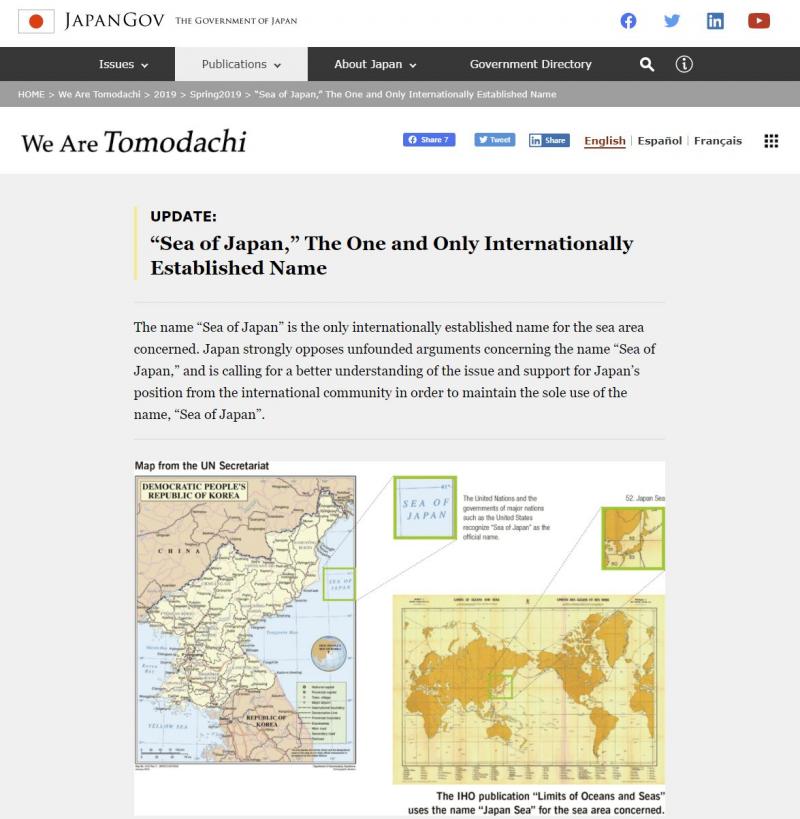|
| 서한 |
시정서한 |
|
| 매체 |
웹사이트
|
|
| 이슈 |
동해
|
|
| 언어 |
영어
|
|
| 서한보내는곳 |
https://www.kantei.go.jp/foreign/forms/comment_ssl.html |
|
| 오류내용 |
오류 내용 동해를 sea of Japan 으로 표기함 |
|
| E-mail / Contact |
ashleylsylee@gmail.com |
|
서론 |

To Whom It May Concern:
To each and
every government there is an opinion that is prevalent, this does not mean it’s
right, but it is a belief that is held by many. The same is true for the naming
of the seas between Korea and Japan. On
September 17, 2020, I happened upon your government site and saw this page, https://www.japan.go.jp/tomodachi/2019/spring2019/sea_of_japan.html
, arguing the validity of the designation “Sea of Japan.” I am
writing to you to disagree. I was deeply distressed to find that you have
chosen to name designate the East Seas as only ‘Sea of Japan’ and consider it extremely
inappropriate and frankly appalling, that Japan will not heed International law
and be so ill informed to blatantly use such designation with complete lack of
regard for the dispute between the Korea and Japan.
|
|
| 본론 |
For more than 2,000
years, not just Koreans, but people throughout the world, viewed the body of
water on the eastern boundary of Asia between Korea and Japan as the East
Se a. In order to resolve the controversy, in 2019, the
International Hydrographic Organization (IHO) reportedly urged Japan to
negotiate with the Republic of Korea. The IHO was founded in 1921 to
standardize the names of seas and oceans and support safe navigation of ships.
The name the East Sea was on world maps, including old Japanese maps, until the
publication of S-23 “the
Limits of Oceans and Seas” by IHO in 1929. During
the time when the IHO was creating a list of the names of oceans and seas,
Japan had occupied and imperialized Korea starting in 1910 and ending in 1945.
Accordingly, Korea was unable to participate in the decision-making
process. As a result, only the name Sea of Japan was used in the
publication, which fueled the spread of the name on world maps and in
textbooks. This practice remained in the second (1937) and third edition (1953)
of the publication of S-23 “the Limits of Oceans and
Seas” because Korea was either under Japanese rule from
1910 to 1945 or engaged in a war from 1950-1953, the time of the
publications. According to IHO and UNCSGN, in case of
topographical feature shared with two or more countries, yet naming differently
in their own languages, all the names in each language should be
marked. Once Korea and Japan agree on a common designation that is in
accord with the general rule of international cartography we will then follow
the agreed-on designation.
Articulating the correct use of the
names for the body of water between Korea and Japan is not simply a question of
naming a geographic area but is part of a national effort by the Korean
Republic to erase the legacy of Japanese Imperialism and to redress the
unfairness that has been resulted from that period. The way
African-Americans were enslaved, so was the Korean people. Therefore, I urge
you to use 'East Sea' to describe the body of water in question or to use both
Korean and Japanese designation simultaneously (e.g. 'East Sea/Sea of Japan')
in your contents and maps.
|
|
| 결론 |
I feel that the Japanese Government, should be
sensitive to the situation and acknowledge the pressures. As the world is
ravaged by not only by Covid-19, but racial injustice and discrimination the
least that could be done is to abide by international law. I ask that you
contact me with changes and look forward to visiting your site with the implemented
change. You can email me at ashleylsylee@gmail.com with
your response, it would be greatly appreciated. Thank you. And I look forward
to hearing from you soon.
Sincerely,
Ashley Lee |

